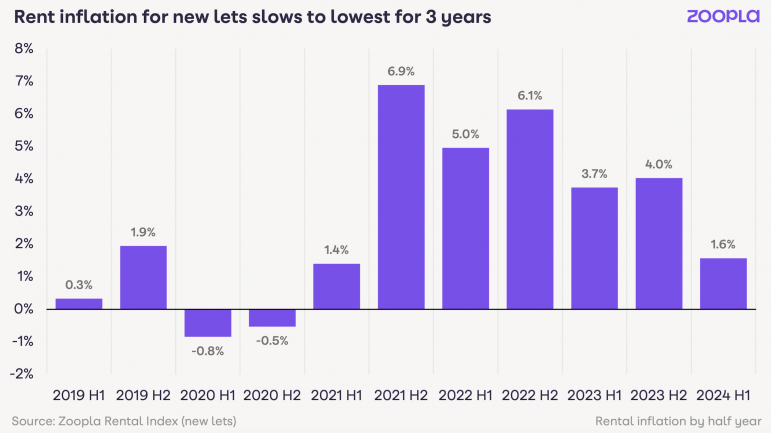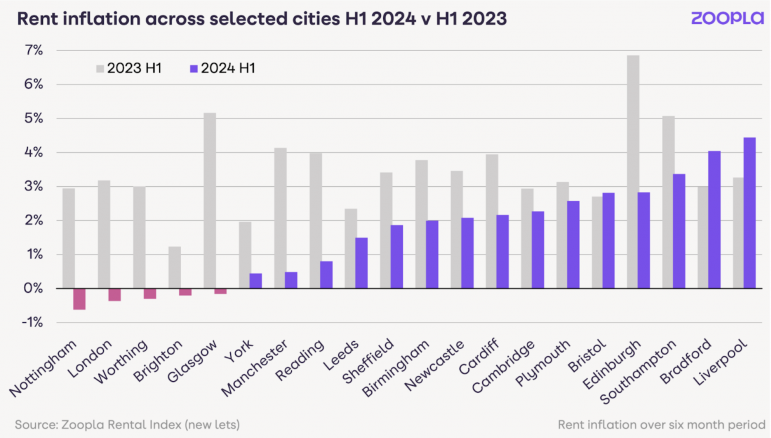
Rents have been rising faster than earnings for three years but there are clear signs that the recent boom in rents for new lets is coming to an end. Welcome news for under pressure renters worried about the cost of renting and planning a move in the rental market. Landlords can still expect rents to keep rising but at a slower rate than we have seen over the last three years.
Demand for rented homes has fallen by 39% over the last year off a very high base. The rental market has moved from ‘red-hot’ to still ‘hot’. Zoopla data shows there are 17 people chasing every home for rent, still 2x the pre pandemic average (2017-2019).
The supply of homes available for rent per estate agent is rising slowly up 17% in the last year as more homes are bought by corporate landlords, often new builds, and lower mortgage rates make it a little easier for renters looking to buy their first home.
The general availability of homes for rent remains a major challenge for renters and the average agent has third fewer homes for rent than the pre pandemic average.
Rents rise at slowest pace for almost three years
Rents for new lets have risen by 5.7% over the last 12 months to a UK average of £1,232 per month.
Rents have risen just 1.6% in the first half of the year, the lowest since 2021 highlighting how much the heat is coming out of the rental market, mainly as a result of affordability pressures.
On current trends UK rents for new lets are on track to be 3-4% higher over 2024 versus 8% in 2023 and 11% in 2022.
Three quarters of cities record lower rent inflation than a year ago
Changes in supply and demand at a city and local level are impacting rents to different degrees. A slowdown in overseas student applications and a weaker labour market explain some of the weakening in demand for renting. Falling mortgage rates are helping renters looking to buy become first time buyers freeing up some homes that are rented for others.
In some cities rents have been rising so fast they have ‘over-shot’ what renters are prepared to pay. Rents are posting small falls in some cities.
Zoopla’s rental index tracks rents across 64 cities. In the first 6 months of 2024, rents have fallen in five cities while the rate of inflation is much lower across 75% of cities.
However, there are cities where rents are still rising fast e.g. Bradford and Liverpool where there is headroom for rents to rise at a faster rate. Most locations where rents are rising quickly are accessible suburbs to larger cities or areas where rents are still offering some value for money. Rochdale, Doncaster, Sunderland, Southend and Telford have also recorded rental inflation of over 4% in H1 2024.
Rents fall across a third of London boroughs
London is the UKs most expensive market to be a renter with an average monthly rent of £2,172, almost 70% higher than the UK average and more than 2x many other regions.
The high cost of renting means affordability is a growing constraint on rental inflation and our index shows rents have fallen in more than a third of London boroughs in the first half of 2024. The falls have been concentrated in inner east London led by Tower Hamlets, Newham and Greenwich.
Corporate investors are buying new homes for rent boosting supply and increasing choice which is one reason rents have been rising more slowly across London alongside affordability constraints.
Rent inflation has slowed across all areas of the capital but the higher growth rates are being registered in the outer London areas where rents are below the London wide average led by Merton and Havering.
Landlords still rationalising portfolios
As the rental market returns to normal rates of rent inflation we continue to see some landlords list homes for sale that were previously rented. An above average proportion are homes in London and the South East where higher mortgage rates and lower yields mean a challenge refinancing to higher rates with a larger sized mortgage. A higher rate taxpayer can’t make a 50%+ loan to value buy to let mortgage work in London which is hitting demand at a time when prices are flat.
The good news is that the underlying cashflow from rented home remains strong and a real attraction for investing. The landscape for investing is simply shifting from a focus on using leverage (debt) and capital gains to drive returns to a focus on the value of cashflow.


